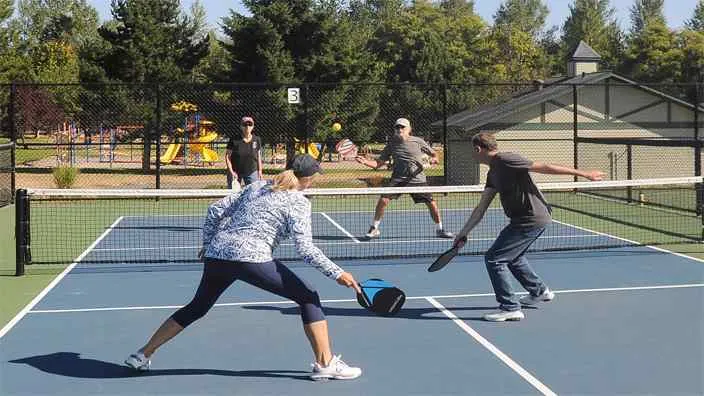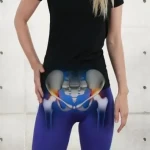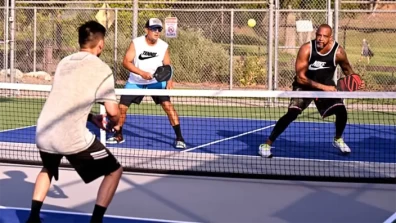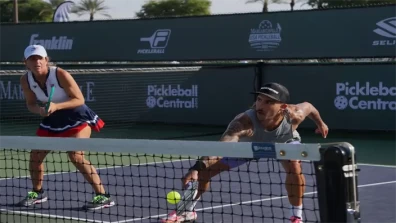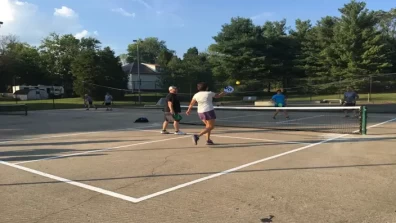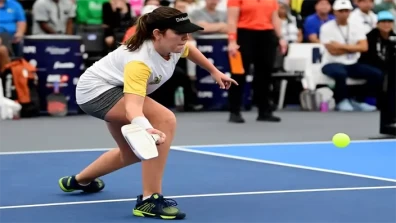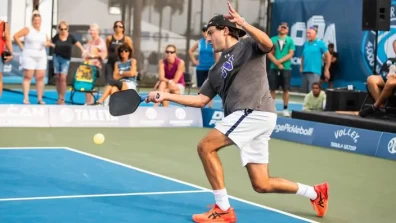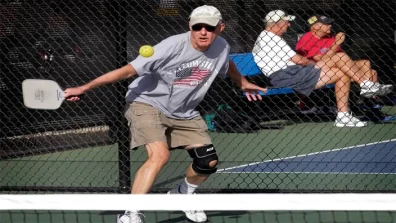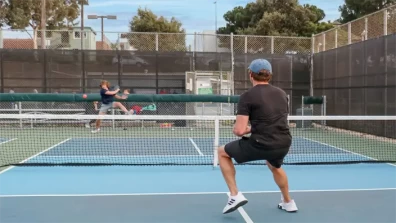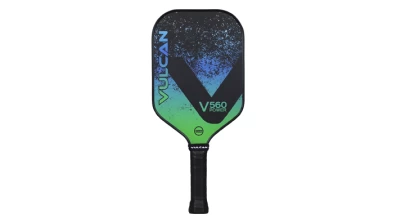The pickleball court seems no less than a battleground where heroes with paddles fight for honor and glory. You're here, in the arena, with the rest of the crowd, waiting for the start of a match that has yet to begin. You’re deeply submerged, and making scenarios about the upcoming exciting events of the game, when a query pops up in your mind: is it possible to bounce the ball on a pickleball serve? You don't want to be on the receiving end of an illegal pickleball serve, something you've just heard rumors about. Let's delve deeply into this issue and demystify the rules and regulations about bouncing pickleball.
Table of Contents
Latest Pickleball Serve Rules
Annually, there are a few tweaks and amendments made to the pickleball regulation book. Players should spend some time getting up to speed on the updated pickleball serve rules. These regulations spell out what is and is not allowed, guaranteeing a fair competitive environment.
Explore More: Can You Play Pickleball Singles?
The enigma is: Does the rulebook cover the pickleball bounce serve regulations? In a word, yes! Under the present rules, a player has the option of using a drop serve in pickleball, which involves letting the ball bounce before striking it. This was a major shift, and many players have adjusted their strategies accordingly.
What Are The 5 Serving Rules In Pickleball?
There are many regulations to remember when playing pickleball, but here are the five golden serving rules that every player must learn by heart. These serving rules are as per the 4.A.8. from the International Federation of Pickleball.
- An underhand serve is required.
- When hitting the ball, the paddle needs to get underneath the player's hips.
- When serving, the player must keep both feet behind the baseline.
- Serving the ball diagonally such that it enters the opposite service box is mandatory.
- The ball has to go over the kitchen, the area outside of which volleying is prohibited.
Pickleball servers will be able to drop the ball and strike it again after it bounces as per the latest rules. When compared to the standard serve, in which the player must release the ball before hitting it in the air, this is a major change. With the new pickleball drop serve rule, players have greater leeway and it could be simpler for beginners to get the hang of basic serving before diving into the pickleball drop serve rule.
Why The Consideration Of Bouncing Matters In Pickleball?
In pickleball, the ball must bounce once on the other side of the net before the receiving player may hit it. We call this pickleball bounce serve rule the "double bounce rule." Although seemingly uncomplicated, this actually increases the challenge and excitement of the game.
Then why is it such a huge deal if you let the ball bounce? For starters, it causes a slight slowdown in the game pace. Just picture yourself slamming the tennis ball directly off the serve. The emphasis may shift from strategy and expertise to a contest of reflexes. The double bounce rule forces you to be more strategic with your placement and timing, to continue with the central idea of strategy. You need to serve the ball in such a way that your opponent has a hard time returning it.
Another advantage of having to let the ball bounce is that it levels the playing field for all players. Since you have more time to set up your shot, players of all ages and ability levels can enjoy it. More unexpected fun? Known as the "kitchen" or the "non-volley zone." You are not allowed to volley the ball in this region. You must allow it to bounce. Where did the name "kitchen" come from? Nobody knows for sure, but it's a foul if you enter the kitchen before letting the ball bounce. And no one likes taking the blame in a game of pickleball.
Longer rallies are possible due to the bounce rules. Who doesn't enjoy an exciting battle to the finish? It maintains the interest of both the spectators and the participants. You need to be alert and anticipate where the ball will land next. And because you're having so much fun, you won't even realize how much of a fantastic workout you've just had.
The Psychology Behind The Bounce
Even something as seemingly little as bouncing a ball can have a significant effect on your mood and ability to concentrate. The concept of rituals, or set patterns of behavior that help set the stage for positive mental states and productive outcomes, is central to this adventure. Let's see if bouncing a ball has any effect on your brainpower.
1- Mindfulness & Tactile Stimulation
Touching the ball stimulates your sense of touch in two ways. The brain receives soothing signals from the tactile experience. This is the same phenomenon that makes stress balls so useful. Study findings were published in the journal "Frontiers in Psychology," suggesting that sensory input has a role in the management of both mood and focus.
2- Pattern Recognition
Skilled gamers tend to have excellent pattern recognition capabilities. They can judge the ball's speed, direction, and spin to better predict where it will land after it bounces. This skill can be developed through repeated use.
3- Decision-Making Under Pressure
In the heat of a fast-paced rally, the psychology of the bouncing ball takes on new significance. Decisions regarding whether to attack, defend, or simply maintain the ball in play must be made quickly. This calls for quick thinking and the flexibility to adjust to the ball's unpredictable bounces.
4- Emotional Resilience
Pickleball has the potential to be a highly charged experience. When a game is won or lost, players might experience a wide range of emotions. It's crucial to your success that you learn to control these feelings and keep an optimistic outlook. The bouncing ball represents both possibility and difficulty.
5- Mental Toughness
Players' mental resilience is also put to the test by the psychology of the bouncing ball. They need to keep their heads in the game when their opponent utilizes deceptive strokes or the ball doesn't bounce as planned. Keeping one's cool and composure can prove decisive, and help winning the game by exercising their mental dexterity.
Frequently Asked Questions
Can You Drop & Hit A Pickleball Serve?
The tennis-style "drop and serve" is not allowed in pickleball. When serving, the ball must be struck below the server's waist. Keep your feet behind the baseline and try to hit a diagonal shot that lands outside the "kitchen" region of the court. After dropping the ball, you must strike it in midair without letting it bounce. If you can perfect this serve, you'll have a leg up on the competition.
What Are The Rules For Serving In Pickleball?
In pickleball, the underhand serve is mandatory, and so is hitting the ball below the waist. Don't step over the baseline. Try to avoid the 7-foot "kitchen" at the net by shooting diagonally into the opposite team's service box. It is not acceptable to hit a bounced ball. You're usually only given one chance to serve. Doubles players should switch sides once each point is scored. Make a point of announcing the score before you serve, and serve from the right side of the court at first.
What Is A Bounce Hit In Pickleball?
In pickleball, a "bounce hit" is a shot taken after the ball has bounced on your side of the court. Due to the "double-bounce rule," it is an essential part of the game, particularly for novices. Each team must wait for the ball to bounce once in their own territory before attempting a volley or hitting it out of the air. This occurs after both the serve and the return. Therefore, no aerial hits are permitted until the ball has bounced twice (once on the serving team's court and once on the receiving team's court).
Can The Ball Bounce In The Non-Volley Zone On A Serve?
No, on a pickleball serve the ball is not allowed to bounce in the "kitchen," or non-volley zone. A fault is automatically committed if it occurs. This new rule will make the game much more interesting. Your serve needs to be expertly done so that it not only goes over the net but also lands in the service box of your opponent. This maintains a level playing field by preventing the server from acquiring an unfair edge and is fun for both players. So, the next time you're serving, bear in mind: no kitchen balls!
Conclusion
Is it possible to use a bounce serve in pickleball? As far as you play by the guidelines, the response is an enthusiastic yes. With this information in mind and a paddle in hand, you may confidently take on the court and serve with ease. Keep in mind that you need strategy as well as skill to win. Know the rules as they evolve, and may your serves always find their mark.

